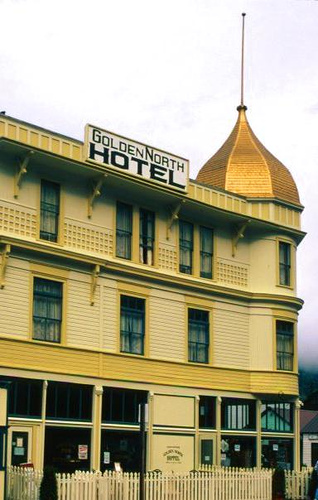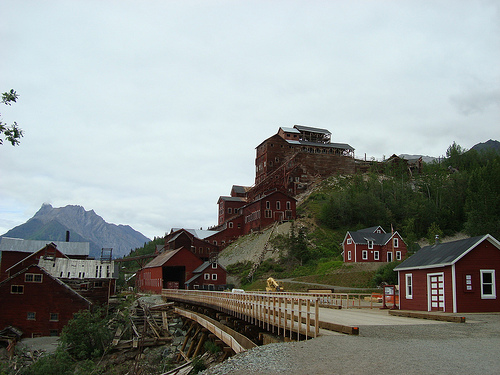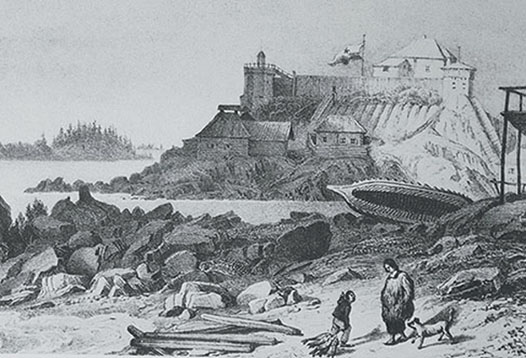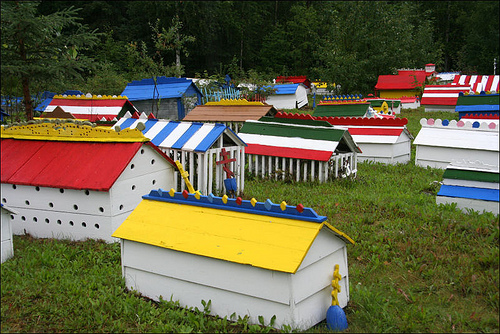“Scary Mary” and other Ghost Stories from Alaska
Back To Blog
With settlements built on top of sacred Native sites, the shadow of bloody 20th century conflicts, and the hard fates of those seeking to mine Alaska’s treasures, the state is rich with spooks and tall tales. Sit down, draw close to the fire, and let us regale you with some tales of haunted Alaska. That Arctic breath at your neck may not just be the autumn chill.
Scary Mary at the Golden North Hotel

This photo is used under a Creative Commons license by Noel Zia Lee
One of Alaska’s most legendary ghosts, Scary Mary’s tale begins with a Gold Rush expedition. Mary came to the Golden North Hotel in Skagway as a blushing young woman engaged to a prospector named “Klondike Ike.” Flush with hopes for their future, Mary’s fiancé set off to win a fortune in the gold fields…and never returned.
Mary waited. And waited. It is said she locked herself in the couple’s room, beset with worries. When the concerned hotelkeepers finally broke down the door, they found her dead, dressed in the wedding dress she was meant to have worn on her wedding day.
But Mary hasn’t yet “checked out” of the Golden North Hotel.
Since her untimely end, guests have been spooked by the apparition of a pale figure looking out from the hotel’s windows, still on the watch for her lover’s ghostly return from the mountains. Sometimes they feel a pocket of cold air whoosh by in the hallways as a phantom in white brushes by. Even more eerily, the odd patron has awoken to Mary’s ghost poised above their beds – just checking, they say, to see if Ike is in bed with another. That’s enough to make anyone sleep with one eye open.
Prankster Poltergeists at the University of Alaska

This photo is used under a Creative Commons license by Andrew Brown
The University of Alaska’s Wendy Williamson Auditorium seems like it was created to be a nesting place for ghouls — a half-finished catwalk and elevator shaft give the space a carnival funhouse feel. The real fun, however, is had by a cadre of ghosts who enjoy pranking and scaring students and spectators at the auditorium.
The odd events that have occurred over the years are no act: the ghosts of a man, woman, kids, and a teenage boy like to get into all kinds of mischief, including slamming the stall doors in the women’s bathroom while the poor ladies struggle to get out. They also have a habit of sabotaging productions. Actors sometimes hear the pitter patter of ghostly feet as props slide about the stage, lights explode and fall, and bizarre shadows appear on the walls. One of the ghosts apparently has a vendetta against brunettes, too: women with long brown hair have been pushed as they take the lobby stairs.
If you happen to visit the Auditorium on your trip, keep a look out for this family of ghouls.
Copper Miners Put the “Ghost” in Ghost Town

This photo is used under a Creative Commons license by mazaletel
Alaska’s lucrative yet precarious mineral wealth has sent many men and women to their early graves. In the case of the Kennecott Copper Mines, an entire community of ghosts worked in cahoots to prevent redevelopment of the area.
Located near Wrangell St. Elias National Park, the Kennecott mines were some of the richest ever plundered in the remote Alaskan wilderness, and the railroad built to transport the harvested copper down to the coast was a monument to the crazy things that people will do for profit. Known as the Copper River & Northwestern Railway (or “Can’t Run & Never Will” to skeptical locals), many men perished while creating a railroad that crossed glaciers, chasms, and required tunneling through rock.
By all accounts, these men stuck around, even though no rail car has creaked over the abandoned railroad tracks in more than 70 years. After the railroad halted and the boom towns disbanded, visitors traveling along a stretch of road near Chitina bordering the railway reported tombstones appearing and disappearing on the roadside. Things got really spooky when a housing project was planned near the old tracks: workers could barely concentrate as the wraithlike voices of miners and children echoed in the mountains. They saw ghostly figures and then, to add insult to injury, tools began to fly straight out of their tool belts, never to be seen again. Soon after, work in the area ceased.
The message, written in a ghost’s hand? Sometimes an abandoned mine should stay that way.
A Mourning Aristocrat Haunts Her Old Castle

This photo is used under a Creative Commons license by Postels
Many people forget that Alaska was once a Russian territory before being transferred to American possession in the 19th century. Though no structures from that period are standing, one historic site in Sitka holds the foundation of the ancient Baranof Castle, the home of Russian royalty who kept watch over their impressive lands after wresting them from native Tlingit tribesmen. When the United States’ purchase of the territory was finalized at Baranof Castle, the family in residence sailed away from their stately home.
Soon after the family’s departure, newspapers began to report the presence of a ghost – a beautiful and doomed Russian Princess haunting the site. Decked in a black robe of mourning and opulent jewels, the princess drifted through the castle during the night, sadly bemoaning her fate. Rumors and even news reports circulated that the princess had killed herself on her wedding night in order to avoid an arranged marriage with a man who was not her true love. Today, “Castle Hill” State Historic Site is a great place to catch a glimpse the ethereal Lady in Black.
The Living Construct Homes for the Dead at Eklutna Village Memorial Park

This photo is used under a Creative Commons license by Raymond Bucko, SJ
Eklutna, Alaska represents an intermingling of Athabascan and Russian ceremonial tradition in one peaceful location with rich links to the spirit world. Eklutna is located on the Cook Inlet, and was the home of the Danaina tribe of the Athabascan native peoples for centuries. In 1830, Russian Orthodox missionaries joined the community and constructed the St. Nicholas Church.
In the church’s cemetery plot, visitors see a curious sight: traditional Orthodox crosses placed at the heads of graves and Athabascan spirit houses. These colorful houses are about the size of a doll’s house, and are set over the fresh mound of dirt from a recent burial. The Athabascan rites go as follows: after someone has died, a blanket is laid over the gravesite to soothe the newly-dead on his passage to the afterlife. After 40 days have passed, the spirit house—painted in colors that represent the family of the deceased—is placed on top of the blanket as a home for the soul and a labor of love. Each house is unique, and some even feature architectural touches like tin roofs and cupolas. As a nod to the inevitable passage of time, houses are not touched up after being erected.
A visit to the Eklutna Village Memorial Park means brushing past many layers of Alaskan spirits: the Danaina, Russian settlers, and later U.S. pioneers who found their way to the town. It’s a true Alaskan blend.
Know of other haunted spots in Alaska? Share your spine-tingling tale in the comments below!